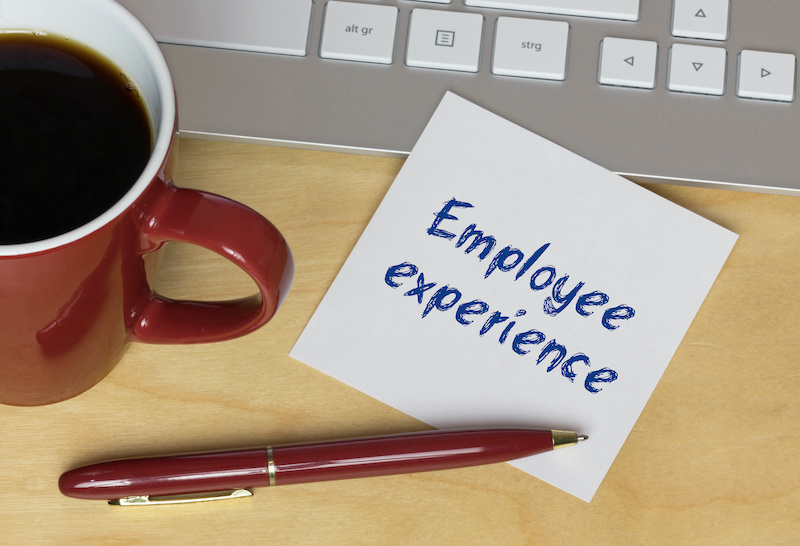Barb Froncillo, National Sales Director at INTOO USA, spoke recently with Michele Shuey and Veronica Mowchan of Integrate about the employee experience they’ve successfully implemented at their organization. Having an experience like theirs can help attract and retain talent, and keep employees engaged throughout the employee lifecycle.
Watch the entire webinar recording here.
Here’s a summary of key learnings from the webinar.
Attract Candidates with the Right First Impressions
Distinguish your organization as an employer of choice by ensuring that your website and social media—any touchpoints for a candidate—accurately and honestly reflect your company’s values and what it’s like to work there. This will help to ensure that a new hire’s experience working for you matches their expectations. Your culture, the work experience, employee recognition program, and your diversity and inclusion initiatives are worth sharing with intention so that you attract the right people to your organization.
By creating a candidate profile that identifies the traits that would satisfy a role, you can streamline the interview process with targeted questions that will help discover whether the candidate possesses these traits.
Be clear about who you are and who you want working with your organization, and then communicate that effectively across all of your channels.
Have a Positive Candidate Experience
The candidate experience begins with the very first touchpoint a job seeker encounters with your organization, and continues through the hiring decision and offer. Connect with candidates throughout the process in a timely fashion to keep them informed and excited about the potential to work with you.
This engagement sets the stage for how the candidate can expect to be treated by your company after hire, and so it’s important that the hiring manager, IT (responsible for getting a new hire set up), and the HR team collaborate to make the process successful. Doing so helps build confidence in the new hire that they’ve made the right choice in accepting the opportunity.
Standardize a Process for the First 90 Days
Having a process in place for onboarding helps a new hire get settled, feel comfortable, and be successful more quickly. Such a process should involve giving the new hire information about the company’s culture, value proposition within the marketplace, product, and industry. The hiring manager should ensure that the new hire completely understands their role and what is expected of them within the first 90 days.
Think about what would make a new hire most comfortable and get them set up in such a way that they could hit the ground running.
Reward and Recognize Employees
Make sure your employees feel valued by acknowledging their work and achievements. Create a recognition program to reward employees for outstanding performance, and build it in a way so that all employees have an equal opportunity to be recognized (as opposed to only senior management or those with a high level of visibility). Incorporate feedback and financial rewards (where applicable). Consider celebrating work anniversaries and other team accomplishments with in-person or virtual parties.
This kind of recognition helps to inspire great work, drive engagement, and results in exceeding expectations.
Create Opportunities for Growth and Career Development
Providing opportunities to grow and move around the organization can be a huge driver for retention. It also helps to build a strong workforce and leadership. Acknowledge that a career path isn’t always vertical; often it zig-zags. Map the careers within your organization with the applicable skills so that employees can figure out how and where they can apply their talents elsewhere within the company. Encourage an agile workforce and support succession planning and change management by offering skills-based training to all employees and leadership development for those interested.
Provide Assistance for Career Transition
Whether an employee is moving around the company or transitioning out of it, offer support by setting them up for success.
For an employee moving into a different internal role, this means providing a version of onboarding that helps them adjust and become familiar with the new team and responsibilities.
For an employee leaving the organization electively, it means treating them respectfully and ensuring that the remaining team members are prepared with a knowledge transfer. A smooth exit experience for the departing employee helps to ensure an enduring positive impression which will help protect your employer brand and, taking the lifecycle and employee experience full circle, help to attract new talent.
Watch the webinar to hear how Integrate’s employee experience has benefited the organization.
About Michele Shuey, HRM-SCP, CPTD
Michele is Senior Director, People Development at Integrate. She’s a people-focused and results-driven professional with 23 years of experience in the talent management space. Michele has spent nearly two decades fueling a career with a passion for identifying, growing, and engaging top talent to help companies become “an employer of choice.”
About Veronica Mowchan
Veronica is Senior Director, People Solutions at Integrate. She’s an HR professional with over ten years of experience and a background in organizational psychology. Veronica spends her days solving complex workplace issues with a “person-first approach” and creating an inclusive space for all employees to thrive.
Missed this webinar? Be sure to sign up for our newsletter to be alerted of future events!In every stage of the employee lifecycle, INTOO helps employers protect their brand through effective candidate experience, career mobility, and outplacement services. Contact us to learn how we can make a difference for you and your employees.JTNDaWZyYW1lJTIwc3JjJTNEJTIyaHR0cHMlM0ElMkYlMkZyZXNvdXJjZXMuaW50b28uY29tJTJGaHVic0Zyb250JTJGZW1iZWRfY3RhJTJGMzU0Mjg5JTIyJTIwc2Nyb2xsJTNEJTIybm9uZSUyMiUyMGJvcmRlciUzRCUyMjAlMjIlMjBmcmFtZWJvcmRlciUzRCUyMjAlMjIlMjB3aWR0aCUzRCUyMjI1MCUyMiUyMGhlaWdodCUzRCUyMjMzMCUyMiUzRSUzQyUyRmlmcmFtZSUzRQ==
Robyn Kern is a seasoned business writer who has written in the HR, education, technology, and nonprofit spaces. She writes about topics including outplacement, layoffs, career development, internal mobility, candidate experience, succession planning, talent acquisition, and more, with the goal of surfacing workforce trends and educating the HR community on these key topics. Her work has been featured on hrforhr.org and trainingindustry.com.











